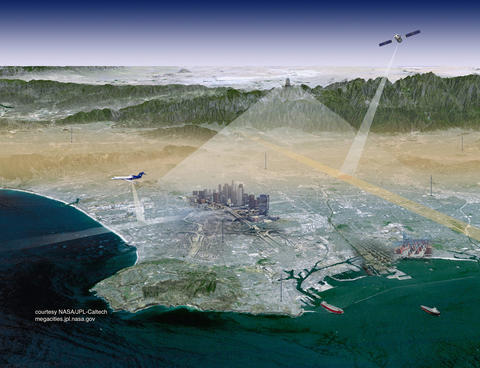
Sensors located around Los Angeles provide measurements of greenhouse gas mixing ratios of carbon dioxide, methane and carbon monoxide. Aircraft, mobile laboratories and satellites contribute remote-sensing measurement.
A greenhouse gas field measurement research program developed by scientists at the National Institute of Standards and Technology (NIST) and several collaborating institutions has been named a "Project to Watch" by a United Nations organization that focuses on harnessing big data for worldwide benefit.
The Megacities Carbon Project was launched in 2012 to solve a pressing scientific problem: how to measure the greenhouse gases that cities produce. Urban areas generate at least 70 percent of the world's fossil fuel carbon dioxide emissions, but gauging a city's carbon footprint remains difficult due to the lack of effective measurement methods. The project aims to change that by developing and testing techniques for both monitoring urban areas' emissions and determining their sources.
The large sensor networks that each city in the Megacities Carbon Project employs generate huge amounts of data that could reveal the details of the cities' emissions patterns. It is the project's use of this so-called "big data" that drew accolades in the Big Data Climate Challenge, hosted by U.N. Global Pulse and the U.N. Secretary General's Climate Change Support Team. The ability to analyze big data—vast quantities of electronic information generated by many sources—has the potential to provide new insights into the workings of society, and Global Pulse is working to promote awareness of the opportunities big data presents across the U.N. system.
Launched in May 2014, the competition attracted submissions from organizations in 40 countries. The applicants ran from academia to private companies to government initiatives like the Megacities Carbon Project. Two projects earned top honors, while a total of seven were dubbed Projects to Watch.
The Megacities project began with a pilot observing system for Los Angeles supported by NIST, NASA, the National Oceanic and Atmospheric Administration (NOAA), the California Air Resources Board and the Keck Institute for Space Studies. It has since expanded to include an observing system in Paris, France, and has drawn upon the expertise of additional participating institutions.
The project is one of several NIST efforts to improve the accuracy of greenhouse gas measurements in urban areas. These efforts focus largely on the development of urban test beds, where methods for measuring and verifying greenhouse gas data can be explored and improved. In addition to Los Angeles, U.S. test beds are located in Indianapolis, Ind., (the Indianapolis Flux Experiment, INFLUX) and the northeast corridor, with initial development in the Baltimore/Washington, D.C., region.
More information on NIST's work on the Megacities project is available online.
Edited first paragraph on Sept. 16, 2014, to clarify the research nature of the project.

